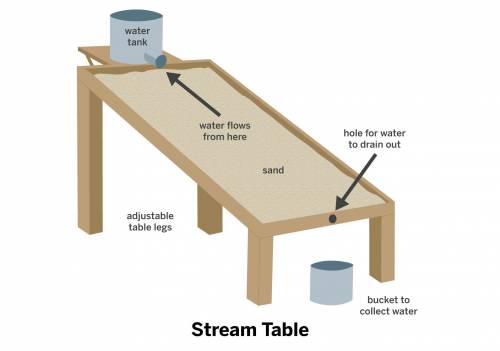
Using Models to Answer Questions About Systems
Armando’s class was looking at images of rivers formed by flowing water. Most of the rivers were wide and shallow, but one river was narrow and deep.
Armando’s class thinks that this river is narrow and deep because:
the hill that the water flowed down was very steep, or
the sand grains that the water flowed through were very small.
Armando designed the model below to try to answer the question: Why is this river so narrow and deep?
1a. What features of this model will help Armando answer the question?
1b. How could Armando use this model to test the idea that very steep hills lead to narrow, deep rivers?
1c. How could Armando use this model to test the idea that very small sand grains lead to narrow, deep rivers?
2. Armando thinks that it is the very steep hill that makes this river narrow and deep, but his classmate thinks it is the small size of the sand grains that the water flows through. What results from the model would be evidence that Armando’s idea is correct?


Answers: 1


Another question on Chemistry


Chemistry, 22.06.2019 09:00
Given the following reaction: c3h8+5o2=3co2+4h20 how many grams of co2 will be produced 7 g of c3h8 and 98 g of o2
Answers: 1

Chemistry, 22.06.2019 13:30
In a ni-cd battery, a fully charged cell is composed of nickelic hydroxide. nickel is an element that has multiple oxidation states. assume the following proportions of the states: nickel charge proportions found 0 0.17 +2 0.3 +3 0.33 +4 0.5 (a) determine the mean of the nickel charge. enter the answer to 2 decimal places.(b) determine the cumulative distribution function of nickel charge.
Answers: 2

Chemistry, 22.06.2019 13:50
What happens when an atom of sulfur combines with two atoms of chlorine to produce sci2? a. each chlorine atom shares a pair of electrons with the sulfur atom. b. an electron is transferred from each chlorine atom to the sulfur atom. c. an electron is transferred from the sulfur atom to each chlorine atom. d. each chlorine atom shares all its valence electrons with the sulfur atom.
Answers: 2
You know the right answer?
Using Models to Answer Questions About Systems
Armando’s class was looking at images of rivers form...
Questions


Mathematics, 24.03.2020 02:56






Computers and Technology, 24.03.2020 02:56







Mathematics, 24.03.2020 02:57

Mathematics, 24.03.2020 02:57

Mathematics, 24.03.2020 02:57

Mathematics, 24.03.2020 02:57

Mathematics, 24.03.2020 02:57




